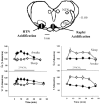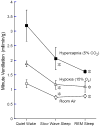State-dependent central chemoreception: a role of orexin
- PMID: 20170755
- PMCID: PMC2975519
- DOI: 10.1016/j.resp.2010.02.006
State-dependent central chemoreception: a role of orexin
Abstract
Sites involved in central chemoreception (CCR) are widely distributed in the brain. One possible explanation for the existence of multiple central chemoreceptor sites is the vigilance state-dependent hypothesis, that some sites are of greater importance in wakefulness others in sleep. We briefly summarize the evidence for a distributed network of central chemoreceptor sites and a vigilance state-dependent differentiation among them. We then discuss the role of orexin in vigilance state-dependent CCR based on our recent studies using orexin knockout mice and focal microdialysis of an orexin receptor antagonist at the retrotrapezoid nucleus and medullary raphe in rats. Orexin affects CCR in a vigilance state-dependent manner that varies with circadian time. Orexin also contributes to emotional stress- and other state-dependent related regulation of ventilation, e.g., the defense response. Diversity in central chemoreception including orexin neurons and the synaptic control of respiratory and cardiovascular output neurons appears to be necessary for animals to adapt themselves to constantly changing situations and behavioral states.
Copyright © 2010 Elsevier B.V. All rights reserved.
Figures




Similar articles
-
Antagonism of rat orexin receptors by almorexant attenuates central chemoreception in wakefulness in the active period of the diurnal cycle.J Physiol. 2010 Aug 1;588(Pt 15):2935-44. doi: 10.1113/jphysiol.2010.191288. Epub 2010 Jun 14. J Physiol. 2010. PMID: 20547681 Free PMC article.
-
Central chemoreception in wakefulness and sleep: evidence for a distributed network and a role for orexin.J Appl Physiol (1985). 2010 May;108(5):1417-24. doi: 10.1152/japplphysiol.01261.2009. Epub 2010 Feb 4. J Appl Physiol (1985). 2010. PMID: 20133433 Free PMC article. Review.
-
Vigilance state-dependent attenuation of hypercapnic chemoreflex and exaggerated sleep apnea in orexin knockout mice.J Appl Physiol (1985). 2007 Jan;102(1):241-8. doi: 10.1152/japplphysiol.00679.2006. Epub 2006 Sep 7. J Appl Physiol (1985). 2007. PMID: 16959906
-
Respiration and autonomic regulation and orexin.Prog Brain Res. 2012;198:25-46. doi: 10.1016/B978-0-444-59489-1.00004-5. Prog Brain Res. 2012. PMID: 22813968 Free PMC article. Review.
-
Contribution of orexin in hypercapnic chemoreflex: evidence from genetic and pharmacological disruption and supplementation studies in mice.J Appl Physiol (1985). 2007 Nov;103(5):1772-9. doi: 10.1152/japplphysiol.00075.2007. Epub 2007 Aug 23. J Appl Physiol (1985). 2007. PMID: 17717124
Cited by
-
Acid sensing ion channel 1 in lateral hypothalamus contributes to breathing control.PLoS One. 2012;7(7):e39982. doi: 10.1371/journal.pone.0039982. Epub 2012 Jul 6. PLoS One. 2012. PMID: 22792205 Free PMC article.
-
Orexin and Central Modulation of Cardiovascular and Respiratory Function.Curr Top Behav Neurosci. 2017;33:157-196. doi: 10.1007/7854_2016_46. Curr Top Behav Neurosci. 2017. PMID: 27909989 Review.
-
An augmented CO2 chemoreflex and overactive orexin system are linked with hypertension in young and adult spontaneously hypertensive rats.J Physiol. 2016 Sep 1;594(17):4967-80. doi: 10.1113/JP272199. Epub 2016 May 29. J Physiol. 2016. PMID: 27061304 Free PMC article.
-
Lateral hypothalamus as a sensor-regulator in respiratory and metabolic control.Physiol Behav. 2013 Sep 10;121:117-24. doi: 10.1016/j.physbeh.2013.03.023. Epub 2013 Apr 3. Physiol Behav. 2013. PMID: 23562864 Free PMC article. Review.
-
Redefining the components of central CO2 chemosensitivity--towards a better understanding of mechanism.J Physiol. 2011 Dec 1;589(Pt 23):5561-79. doi: 10.1113/jphysiol.2011.214759. Epub 2011 Oct 17. J Physiol. 2011. PMID: 22005672 Free PMC article. Review.
References
-
- Berquin P, Bodineau L, Gros F, Larnicol N. Brainstem and hypothalamic areas involved in respiratory chemoreflexes: a Fos study in adult rats. Brain Res. 2000;857:30–40. - PubMed
-
- Chemelli RM, Willie JT, Sinton CM, Elmquist JK, Scammell TE, Lee C, Richardson JA, Williams SC, Xiong Y, Kisanuki Y, Fitch TE, Nakazato M, Hammer RE, Saper CB, Yanagisawa M. Narcolepsy in orexin knockout mice: molecular genetics of sleep regulation. Cell. 1999;98:437–451. - PubMed
-
- Ciriello J, Li Z, de Oliveira CVR. Cardioacceleratory responses to hypocretin-1 injections into rostral ventromedial medulla. Brain Res. 2003;991:84–95. - PubMed
Publication types
MeSH terms
Substances
Grants and funding
LinkOut - more resources
Full Text Sources

